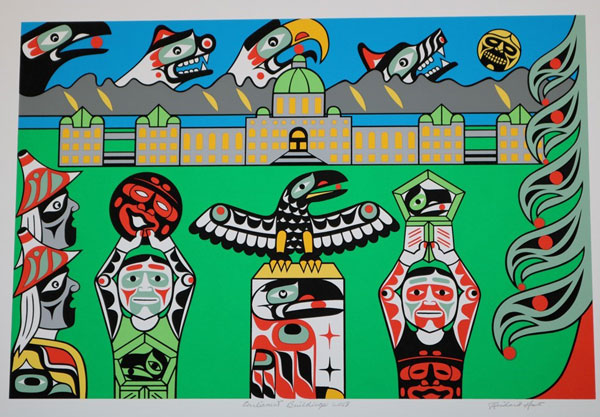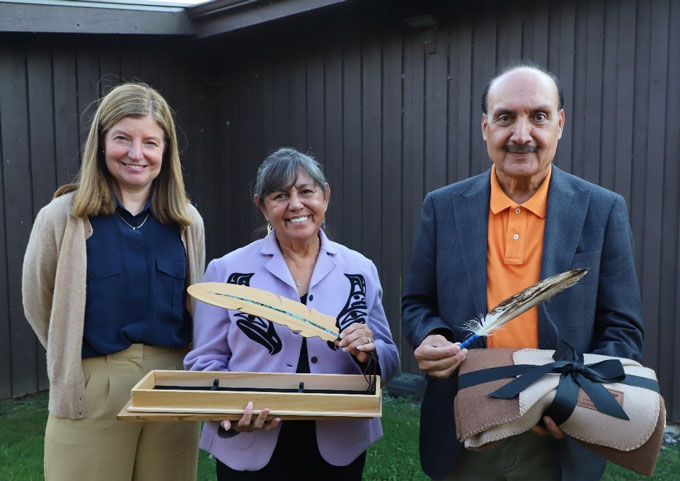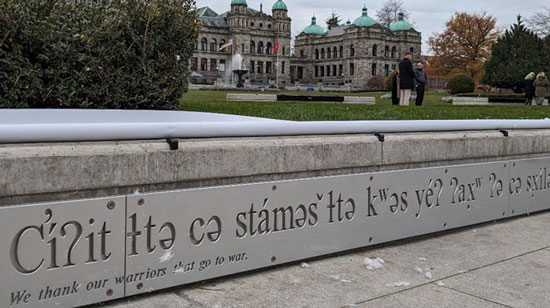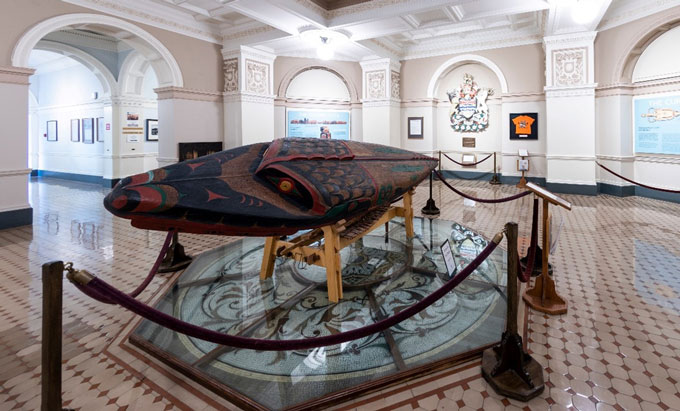As a separate and distinct provincial institution, the Legislative Assembly is committed to contributing to reconciliation with Indigenous Peoples.
Reconciliation recognizes the impact of the Legislative Assembly’s historic debates and decisions on First Nations, as well as the importance of ensuring that Indigenous Peoples feel included in and represented by the Legislative Assembly and welcome on the Legislative Precinct.
Through our reconciliation initiatives, the Legislative Assembly seeks to promote and include Indigenous cultures, languages, traditions, and representation within our institution and its proceedings.

Artwork by Kwakwaka'wakw artist Richard Hunt
The Legislative Precinct, including the Parliament Buildings, other buildings, and surrounding grounds, are located on the traditional territory of the lək̓ʷəŋən Peoples, known today as the Songhees and Esquimalt Nations. The Legislative Assembly has benefitted, and continues to benefit, from the use of these lands which have a long history and significance to the lək̓ʷəŋən Peoples, serving as a hunting and gathering ground, a trading hub, and a point for canoe portage. The Legislative Assembly is grateful to the Songhees and Esquimalt Nations for their continuing relationship with this land, for their enduring stewardship of their territory, and for generously sharing their friendship, wisdom, culture, and traditions. hәysxʷq̓ә siém.
As a provincial institution, the Legislative Assembly acknowledges the history and wisdom of all Indigenous Peoples in British Columbia, including more than 200 First Nations with unique cultures, languages, and systems of governance. The Legislative Assembly recognizes its own historic role in the systemic oppression and discrimination of Indigenous Peoples.
Reconciliation Action Plan, 2024-2028
The Legislative Assembly released its first Reconciliation Action Plan on May 8, 2024. See the news release for more information.
This plan outlines the commitments and actions the Legislative Assembly will undertake to contribute to reconciliation with Indigenous Peoples. The plan acknowledges the need to address historical injustices by acknowledging the past and working to build new relationships with Indigenous Peoples based on respect and understanding.
In developing a Reconciliation Action Plan, the Legislative Assembly is committed to reconciliation as a core value to guide its multi-year planning.
Historical Research
With the release of its first Reconciliation Action Plan, the Legislative Assembly also released a research publication, First Nations and the Legislative Assembly of British Columbia: A Record of Historical Actions, Decisions and Statements in Legislative Proceedings, 1872-1972, which includes 874 records compiling the decisions and debates related to First Nations during the institution’s first 100 years.
This research provides a written record of the Legislative Assembly’s impact on First Nations in its early history and the evolution of some aspects of the institutional relationship with First Nations. This research may be accessed by researchers, educators, and people who want to know more about this important history.
Relationship-Building with Indigenous Peoples
Building a new relationship with Indigenous Peoples is the foundation that guides the implementation of our Reconciliation Action Plan. In recognition of both our local and provincial impacts, the Legislative Assembly looks forward to strengthening its relationships with the Songhees and Esquimalt Nations while seeking to deepen its relationships with Indigenous communities across the entirety of British Columbia.
Speaker’s Indigenous Reconciliation Advisory Committee
The Speaker’s Indigenous Reconciliation Advisory Committee was established in 2023 as a forum for Indigenous leaders to provide input and guidance on the Legislative Assembly’s reconciliation initiatives.
Current membership includes:
Taylor Baker, Executive Councillor for Tsawwassen First Nation;
Howard Grant, Councillor for Musqueam Indian Band;
Chief David Jimmie, Squiala First Nation; and
Chief Willie Sellars, Williams Lake First Nation.
Speaker’s “Listening Tour”
The Speaker and Clerk of the Legislative Assembly visit First Nations communities throughout British Columbia and organizations representing Indigenous Peoples, on behalf of the Legislative Assembly, to strengthen relationships and to receive input on implementing the commitments in the Reconciliation Action Plan.

Speaker and Clerk of the Legislative Assembly with Chief Laura Cassidy of the Tsawwassen First Nation
Legislative Assembly Administration
The Legislative Assembly’s commitment to reconciliation is supported by non-partisan employees of the Legislative Assembly Administration. In 2022, the Administration developed a reconciliation discussion paper outlining how it could support the Legislative Assembly’s reconciliation journey. In addition to leading the implementation of many of the actions included in the Reconciliation Action Plan, employees also participate in mandatory reconciliation training and an employee committee leads several initiatives to further reconciliation within the Administration.
Welcome Signage
On November 29, 2023, the Legislative Assembly unveiled lək̓ʷəŋən Welcome Signage at the front of the Parliament Buildings with representatives of the Songhees Nation, Esquimalt Nation, and community members. This project is a reminder of the Songhees and Esquimalt Nations’ continuing relationship with their traditional territories and our renewed friendship.
Dr. Elmer Seniemten George, an Elder from the Songhees Nation, supported by Andrew Cienski, a language revitalization specialist, worked with the Legislative Assembly to create the lək̓ʷəŋən Welcome Signage.

lək̓ʷəŋən Welcome Signage in front of the Parliament Buildings
Other Featured Initiatives
The Legislative Assembly has made some initial efforts to incorporate Indigenous cultures throughout the Legislative Precinct. There are several Indigenous objects and pieces of artwork in the Parliament Buildings, including a hand-carved red cedar canoe presented as a gift by British Columbia’s first Indigenous Lieutenant Governor, the Honourable Steven Point, a woven Salish Blanket, and a traditional Talking Stick positioned in the Legislative Chamber adjacent to the Speaker’s chair. The front lawn of the Legislative Precinct houses the Knowledge Totem Pole carved by Coast Salish artist Cicero August and his sons.
In recent years, the Legislative Assembly has also been honoured to receive blessings from Elders from the Songhees and Esquimalt Nations at the openings of new Sessions of Parliament. Ceremonial components, including the incorporation of traditional dancing and drumming in proceedings, reflect the evolving, modern-day relationship between the Crown, the Legislative Assembly, and Indigenous Peoples in British Columbia.

Hand-carved canoe (Shxwtitostel) in the Lower Rotunda of the Parliament Buildings
Contact Us
If you would like to learn more about the Legislative Assembly’s reconciliation initiatives, please contact us at: officeoftheclerk@leg.bc.ca.

